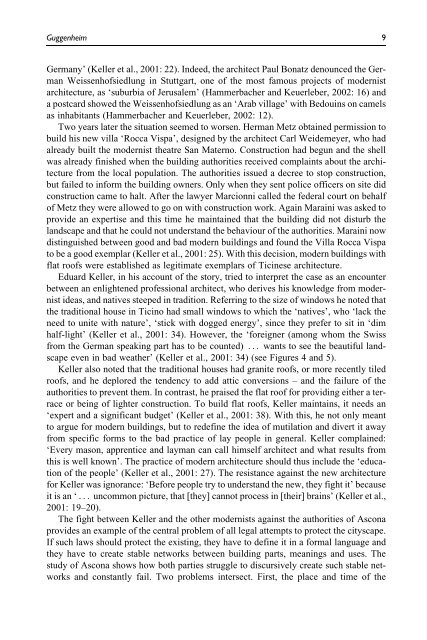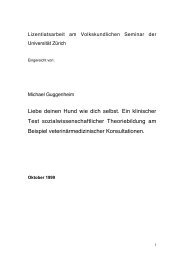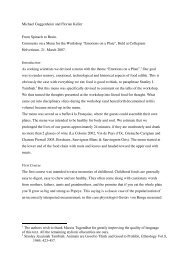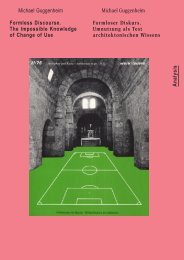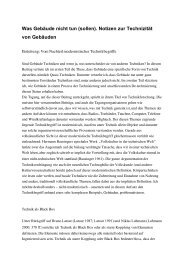The Laws of Foreign Buildings: Flat Roofs and Minarets - Michael ...
The Laws of Foreign Buildings: Flat Roofs and Minarets - Michael ...
The Laws of Foreign Buildings: Flat Roofs and Minarets - Michael ...
You also want an ePaper? Increase the reach of your titles
YUMPU automatically turns print PDFs into web optimized ePapers that Google loves.
Guggenheim 9<br />
Germany’ (Keller et al., 2001: 22). Indeed, the architect Paul Bonatz denounced the German<br />
Weissenh<strong>of</strong>siedlung in Stuttgart, one <strong>of</strong> the most famous projects <strong>of</strong> modernist<br />
architecture, as ‘suburbia <strong>of</strong> Jerusalem’ (Hammerbacher <strong>and</strong> Keuerleber, 2002: 16) <strong>and</strong><br />
a postcard showed the Weissenh<strong>of</strong>siedlung as an ‘Arab village’ with Bedouins on camels<br />
as inhabitants (Hammerbacher <strong>and</strong> Keuerleber, 2002: 12).<br />
Two years later the situation seemed to worsen. Herman Metz obtained permission to<br />
build his new villa ‘Rocca Vispa’, designed by the architect Carl Weidemeyer, who had<br />
already built the modernist theatre San Materno. Construction had begun <strong>and</strong> the shell<br />
was already finished when the building authorities received complaints about the architecture<br />
from the local population. <strong>The</strong> authorities issued a decree to stop construction,<br />
but failed to inform the building owners. Only when they sent police <strong>of</strong>ficers on site did<br />
construction came to halt. After the lawyer Marcionni called the federal court on behalf<br />
<strong>of</strong> Metz they were allowed to go on with construction work. Again Maraini was asked to<br />
provide an expertise <strong>and</strong> this time he maintained that the building did not disturb the<br />
l<strong>and</strong>scape <strong>and</strong> that he could not underst<strong>and</strong> the behaviour <strong>of</strong> the authorities. Maraini now<br />
distinguished between good <strong>and</strong> bad modern buildings <strong>and</strong> found the Villa Rocca Vispa<br />
to be a good exemplar (Keller et al., 2001: 25). With this decision, modern buildings with<br />
flat ro<strong>of</strong>s were established as legitimate exemplars <strong>of</strong> Ticinese architecture.<br />
Eduard Keller, in his account <strong>of</strong> the story, tried to interpret the case as an encounter<br />
between an enlightened pr<strong>of</strong>essional architect, who derives his knowledge from modernist<br />
ideas, <strong>and</strong> natives steeped in tradition. Referring to the size <strong>of</strong> windows he noted that<br />
the traditional house in Ticino had small windows to which the ‘natives’, who ‘lack the<br />
need to unite with nature’, ‘stick with dogged energy’, since they prefer to sit in ‘dim<br />
half-light’ (Keller et al., 2001: 34). However, the ‘foreigner (among whom the Swiss<br />
from the German speaking part has to be counted) . . . wants to see the beautiful l<strong>and</strong>scape<br />
even in bad weather’ (Keller et al., 2001: 34) (see Figures 4 <strong>and</strong> 5).<br />
Keller also noted that the traditional houses had granite ro<strong>of</strong>s, or more recently tiled<br />
ro<strong>of</strong>s, <strong>and</strong> he deplored the tendency to add attic conversions – <strong>and</strong> the failure <strong>of</strong> the<br />
authorities to prevent them. In contrast, he praised the flat ro<strong>of</strong> for providing either a terrace<br />
or being <strong>of</strong> lighter construction. To build flat ro<strong>of</strong>s, Keller maintains, it needs an<br />
‘expert <strong>and</strong> a significant budget’ (Keller et al., 2001: 38). With this, he not only meant<br />
to argue for modern buildings, but to redefine the idea <strong>of</strong> mutilation <strong>and</strong> divert it away<br />
from specific forms to the bad practice <strong>of</strong> lay people in general. Keller complained:<br />
‘Every mason, apprentice <strong>and</strong> layman can call himself architect <strong>and</strong> what results from<br />
this is well known’. <strong>The</strong> practice <strong>of</strong> modern architecture should thus include the ‘education<br />
<strong>of</strong> the people’ (Keller et al., 2001: 27). <strong>The</strong> resistance against the new architecture<br />
for Keller was ignorance: ‘Before people try to underst<strong>and</strong> the new, they fight it’ because<br />
it is an ‘ ... uncommon picture, that [they] cannot process in [their] brains’ (Keller et al.,<br />
2001: 19–20).<br />
<strong>The</strong> fight between Keller <strong>and</strong> the other modernists against the authorities <strong>of</strong> Ascona<br />
provides an example <strong>of</strong> the central problem <strong>of</strong> all legal attempts to protect the cityscape.<br />
If such laws should protect the existing, they have to define it in a formal language <strong>and</strong><br />
they have to create stable networks between building parts, meanings <strong>and</strong> uses. <strong>The</strong><br />
study <strong>of</strong> Ascona shows how both parties struggle to discursively create such stable networks<br />
<strong>and</strong> constantly fail. Two problems intersect. First, the place <strong>and</strong> time <strong>of</strong> the<br />
9


